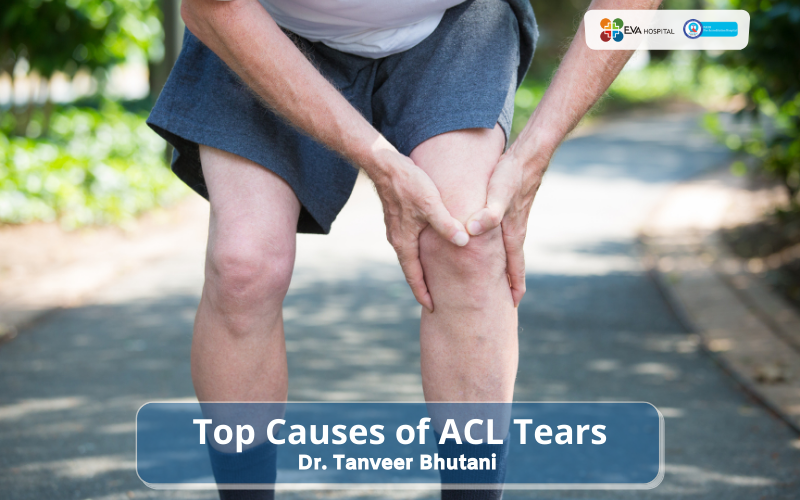
Top Causes of ACL Tears
Introduction
An ACL tear, or torn anterior cruciate ligament, is a common sports injury that can occur without playing sports too.
A bone is connected to another bone by ligaments. There are four primary ligaments in the knee but the ACL is the one most commonly injured.
Connecting the front top part of the shinbone to the back bottom part of the thigh bone, ACL is one of the four primary ligaments of the knee.
The ACL also helps to keep the shin from sliding forward and gives rotational stability to the knee. A tear or strain in the knee that helps to keep one stabilized can make it difficult for one to get around.
There are three grades of Injured ligament also known as a sprain. The ligament is torn making the joint very loose or unstable in the Grade 3 sprain.
The ligament is torn entirely into two, in most ACL injuries. Most of these injuries occur in the middle of the ligament or when the ligament is pulled off the thigh bone.
Signs and Symptoms of ACL Tears
- Knee Popping: One may feel or hear a “popping” in the knee when their ACL is injured.
- Knee Swelling: A great amount of swelling arises within the six hours of an ACL injury and may last for many weeks.
- Pain and Discomfort: The injury puts a stop for most people to whatever activity they were doing. There is a feeling of pain or tenderness in the joint area, especially when weight is put on the injured leg.
- Loss of Motion: One may also feel a loss of complete range of motion combined with an uncomfortable feeling while walking, after an ACL tear. There is a feeling of instability or giving in of the knee too.
Few people can continue activity just after the injury. However, more often one is unable to continue the normal activity post the sprain.
Read more:-What is ACL injury and Does it Require Surgery
Risk Factors and Causes of ACL Injury
Anterior cruciate ligament (ACL) knee injuries mostly happen unexpectedly and without warning. Anyone with an active lifestyle can get an ACL injury, but there are circumstances, activities, and risk factors that increase the probability.
Being female
Women are at higher risk of an ACL injury than men. The probability of ACL injuries is three times higher in female athletes than in males. The reason may be hormonal differences and differences in muscle strength between men and women.
Participation in Certain sports.
ACL tears generally occur in sports like basketball, soccer, football, volleyball, downhill skiing, and tennis. These sports require constant and abrupt downshift, such as pivoting, turning, jumping, cutting, and stopping. These increase the risk of ACL injuries.
Poor Conditioning
A great way to stay in shape and socialize is by playing sports. But it is important to start slow and gradually build up the level when you start playing or take up a sport for fun and fitness. Hard work out when your body is not in shape increases the risk of all types of injuries, including ACL tears or strains.
Improper Footwear
Wearing sneakers or other types of good footwear, such as cleats, that fit properly and are comfortable is advisable and highly recommended. Worn-out shoes or inappropriate footwear can cause strain on your joints and ligaments. They can also lead to falling or slipping.
Trauma to the Knee
Getting hit in the knee is another common cause of ACL injury, particularly if your knee is overextended. This can be caused by a tackle, collision, or any kind of trauma on or off the sports field.
Previously Torn ACL
There is an almost 15% higher chance of re-tearing a formerly repaired ACL than of tearing a normal ACL. The risk is maximum in the first year after the initial injury.
Other
Any trauma like a car accident, falling off a ladder, or missing a step on a staircase can sometimes lead to ACL injury.
Also read: How to prevent sports injuries
Treatment Options
The treatment depends on the severity of the damage and the patient’s activity level. Reconstruction surgery is most likely needed to reduce pain and mobility issues and restore stability after an ACL tear. These tears cannot heal on their own without surgery.
Some people, with a low activity level, choose strengthening programs over surgery. However, they may continue to encounter instability during normal activities such as walking, stair climbing, etc.
The prognosis of complete ACL tears is not very good without surgery. But most people can restore their normal functions & fitness activities without symptoms of knee instability after the surgery paired with rehabilitation.
The strength, balance, and coordination return to near normal after the surgery helping the person lead an unrestricted, normal life.
Overview
ACL tear is a common injury that can happen to any active adult. It can be painful and hamper the usual activities. Dr. Tanveer Bhutani at Eva Hospital says that ACL reconstruction surgery is the best way to treat it.
Combined with physical therapy, it allows the patient to resume a normal lifestyle in a short period. Dr. Bhutani has performed several surgeries successfully and helped sportsmen and people resume the same level of activity as before the surgery.





